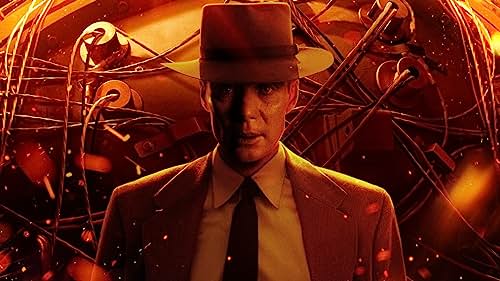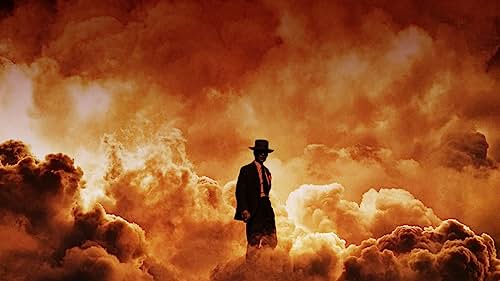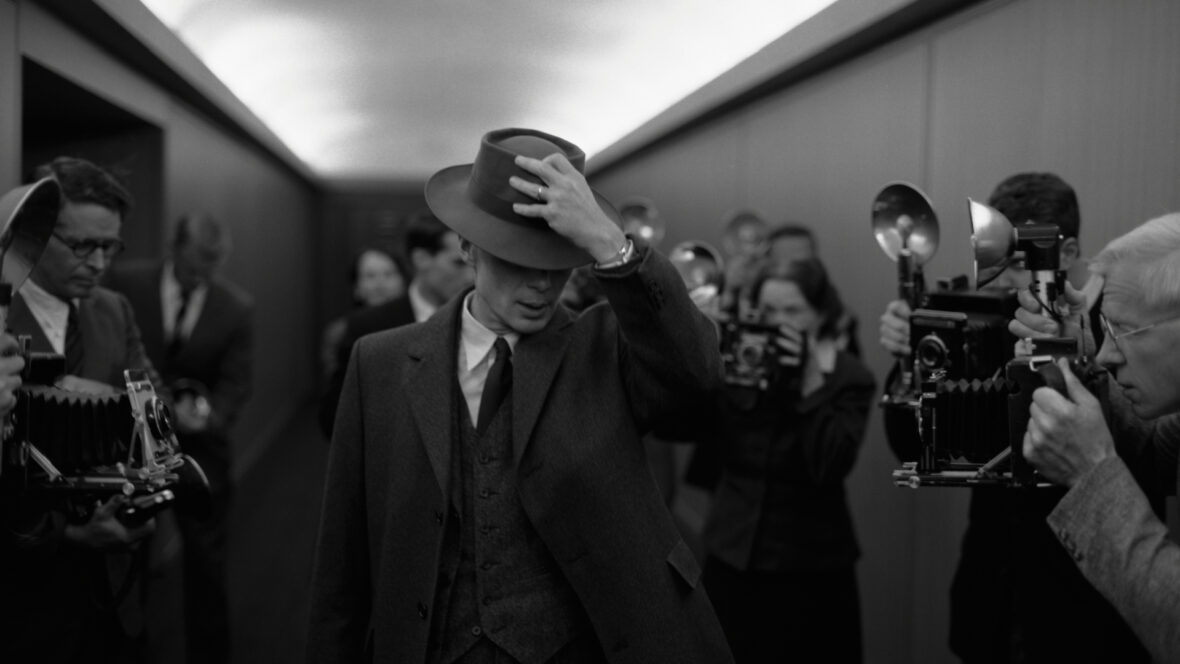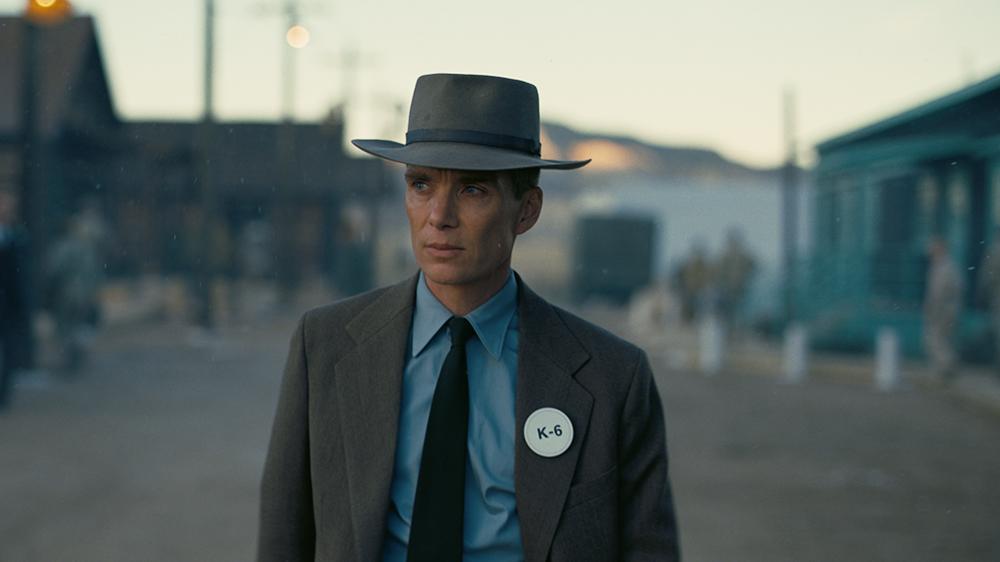
In the opening scenes of this Oppenheimer review, J. Robert Oppenheimer (Cillian Murphy), an American physics student attending graduate school in England and Germany in the 1920s, keeps seeing visions of particles and waves. He has bright blue marble eyes and a wedge-shaped head of curly hair that stands up like Charlie Chaplin’s. The images that are confusing him are visible, together with the pulsing particles and the waves that are illuminated by pulsating bands of light. The visual razzmatazz is exactly what you’d expect from a biopic written and produced by Christopher Nolan: a molecular light display as a representation of the hero’s inner soul. Oppenheimer can glimpse the wild new universe of quantum mechanics.
Even though this Oppenheimer review immediately settles into a more grounded, less fantastical pace, it nonetheless clearly identifies as a Nolan production. It does this by slicing and dicing history written with lightning, political intrigue, scientific inquiry, psychodrama, and chronology in a way that is heady, dense, and dizzying. This isn’t just a metaphor in this case because the movie, which tells the tale of the man who invented the atomic bomb, almost feels like it’s about the creation of lightning.
The Source Material

The film is based on Kai Bird and Martin J. Sherwin’s authorized book “American Prometheus: The Triumph and Tragedy of J. Robert Oppenheimer,” published in 2005. In exploring this Oppenheimer review’s biography, especially his involvement in the Manhattan Engineer District, commonly known as the Manhattan Project, Nolan’s screenplay and direction heavily draws upon the book. He was the director of a secret weapons lab established in a remote area of Los Alamos, New Mexico, where he and a number of other brilliant scientists of the time toiled over how to harness nuclear reactions for the weapons that instantly killed tens of thousands and put an end to the Pacific War.
The atomic bomb and the consequences it had define Oppenheimer’s legacy and influence this movie. Nolan spends a significant amount of time on the bomb’s construction, a fascinating and horrific process, but he doesn’t recreate the assaults; there are also no images of the dead or scenes of burned-out cities, choices that appear to be his moral compass. The picture is permeated with the horror of the bombings, the extent of the suffering they inflicted, and the armaments race that followed. Although this Oppenheimer review is a fantastic success in terms of form and concept and is thoroughly engaging, Nolan’s filmmaking is, ultimately, in service to the history that it depicts.
Check Out: 10 Best Method Actors and the Movies They’re Known For
Admirable Acting

Cillian Murphy portrays Oppenheimer admirably, making him fascinating and multi-layered with his thousand-yard beam, cerebral rake half-smile, and penchant for keeping things close to his chest. His “Oppie” is a classy mandarin who also has a snake-like quality. He is both a cold prodigy and an ardent humanist, an aristocrat and a womanizer, a Jew who becomes a consummate insider, and a man who oversaw the creation of nuclear weapons without any hesitation or remorse before facing the world he created from behind a less self-aware defensive shield of guilt in this Oppenheimer review.
Murphy, sporting Oppenheimer’s signature wide-brimmed porkpie hat, is the focal point of nearly every scene and leaves an impression on your mind. Because Oppenheimer is a relentless, dazzling work of maximalist cinema that you watch on the edge of your brain, the movie demands that. Nuclear fission is the term for the energy released when an atom’s nucleus splits, and Nolan designed Oppenheimer as a form of cinematic fission in this Oppenheimer review.
He breaks the narrative up into pieces that keep crashing into one another, engulfing us in the heat and energy that it all emits. Despite being a masterpiece, Oliver Stone’s “Nixon” is mostly responsible for the aesthetic. But in a less completely realized way, this one is also urgent and crucial in this Oppenheimer review.
In actuality, Murphy’s physicality as a whole is one of the movie’s most effective tools. In contrast to the strong certainty of the military leaders he works with (Matt Damon’s Lt Gen Leslie Groves, for example, is bullish and solid, a clinched fist hunting for anything to punch), he seems impossibly slight, a theoretical idea of a man in this Oppenheimer review.
Oppenheimer is pictured in one scene carrying a stack of books into a brand-new classroom, appearing to be struggling under the weight of his extensive knowledge. Other times, he is serene and cool as glass, appearing to be somehow divorced from the clash of ideas that will eventually become the final weapon in this Oppenheimer review.
Also Read: The Idol Review: The Worst Show of the Summer
The Political History

The movie begins with a flashback to the 1954 U.S. Atomic Energy Commission hearing, where Oppenheimer was ultimately found guilty of having secret Communist affiliations and had his security clearance revoked in this Oppenheimer review.
This was the government’s attempt to silence him since, in the postwar era, he had evolved into something of a dove on the subject of nuclear weapons, a position at odds with America’s aggressive Cold War posture. Using the hearing as a framing device initially seems like a relatively typical thing to do, despite the fact that it was the darkest chapter in Oppenheimer’s life in this Oppenheimer review.
However, over its three hours of running time, the movie keeps coming back to the hearing. Lewis Strauss, played by Robert Downey Jr. with a mesmerizing bureaucratic terseness, is the chairman of the Atomic Energy Commission who became Oppenheimer’s ideological and personal foe (after Oppenheimer humiliated him during a congressional testimonial), and he is the secret force behind the hearing, which is held in a back room away from the press in this Oppenheimer review.
Nolan’s Directorial Choices

The film employs Oppenheimer’s narratives to flash back in time as he defends himself before a panel of hanging judges. Nolan uses this hypnotic multi-tiered storytelling structure to draw out the underlying continuities that influenced Oppenheimer’s life and the development of the bomb in this Oppenheimer review.
Additionally, the narrative doesn’t develop gradually; rather, Nolan hurls you into Oppenheimer’s life’s whirlwind with striking depictions of him at various points in time. The scenario momentarily shifts to the 1920s, where he is a distressed student being tortured by flaming, apocalyptic visions before the attentive older Oppie (as his close friends call him) and his younger counterpart flash onscreen one after the other quickly in this Oppenheimer review.
In addition to suffering, he reads T.S. Eliot’s “The Waste Land,” listens to Stravinsky’s “The Rite of Spring,” and stands in front of a Picasso painting, all of which are representative of a time when space and time were folded into space-time by physics.
Check Out: Spider-Man: Across the Spider-Verse Review: A Visually Stunning Sequel
The Film’s Rising Action

The first part of Oppenheimer is captivating and covers everything from Oppenheimer’s enigmatic encounter with Albert Einstein at Princeton to his far-from-ideal marriage to the alcoholic Kitty in this Oppenheimer review. Almost everything we perceive is astonishingly accurate. Nolan captures the roughness of truth, the intensity, and the specifics of what actually transpired in Oppenheimer, a film that avoids the use of composite characters or storylines that appeal to general audiences.
And the countdown to the development of the first atomic weapon is so intense it almost makes your skin crawl in this Oppenheimer review. The idea that the chain reaction started by the nuclear explosion could spread to the earth’s atmosphere and never end, an Armageddon that theoretical physics can’t completely rule out, is a sinister comedic grace note to the Soviet spies at Los Alamos.
Also Read: Rise of the Beasts Review: Transformers Franchise in Upswing
The Letdown

However, I have to admit that the big blast itself is disappointing when it finally occurs as the bomb is tested in the early hours of that fateful day under the code name Trinity in this Oppenheimer review. Nolan depicts it in an impressionistic manner, with sound interrupting and pictures of what appears to be radioactive hellfire. But it doesn’t convey the terrible awesomeness or nightmare size of it all. It also doesn’t conjure the accounts of the witnesses who claim that the explosion was purple and gray in color and much brighter than the midday light.
Once Oppenheimer moves past the nuclear finale, the film begins to lose some of its buzzing energy. The movie devolves into a pitiable reflection on what the bomb meant, whether it should have been dropped, our rivalry with the Soviet Union, and how Oppenheimer factored into all of that, including his designation as a defrocked Cold War scapegoat.
We’re still at the stupid A.E.C. hearing for two hours in this Oppenheimer review. Oppenheimer suffered atrocious treatment during the height of the McCarthy era. Simultaneously, there are sequences when characters criticize him for his conceit and for making the bomb about him. He receives a reprimand from none other than President Harry Truman in one of them in this Oppenheimer review.
The scene where Oppenheimer, just after the Nazis have been destroyed, explains to a room full of young Los Alamos scientists why he feels it is still OK to use the bomb on Japan may be the most fundamentally genuine one in the film. The dogmatic message we were taught in high school—that unleashing those bombs on Hiroshima and Nagasaki ended the war and helped numerous American soldiers—is something we have all heard in this Oppenheimer review. Since I was fifteen years old, I have never agreed with that justification. I do, however, agree with Oppenheimer that unleashing a nuclear weapon would result in a horrendous example of why it could never, ever be used again.
Oppenheimer, however, who continues to oppose the development of the hydrogen bomb as though it were a completely unrelated weapon to the one he designed and who is desperately trying to stop the development of nuclear weapons in general, is the voice the film finishes with in this Oppenheimer review. For all of his zealous crusading, he actually sends the wrong message. Oppenheimer was entirely justified in feeling tormented by the weapon he had developed.
He also had a certain amount of masochistic naiveté, ignoring the most important lesson of the revolution he helped to lead: that humans will always be at the mercy of what science can accomplish. The film adds a hip doomsday message about how nuclear weapons ruined the world. But by that time, Nolan and his film are doing the same thing as Oppenheimer, who in his own unique manner made the bomb all about him in this Oppenheimer review.
Other issues include the superficial handling of the female characters. Oppenheimer’s mistress Jean Tatlock, played by Florence Pugh, receives little attention. Furthermore, Emily Blunt, who plays Kitty Oppenheimer, the wife of J. Robert, spends most of the first two hours mutinously gripping a martini on the edge of the frame. Later on, she does, however, claim a couple of great scenes: a scene in which she is being interrogated and a wordless gaze in which she expresses her hatred for a disloyal coworker in its entirety in this Oppenheimer review.
Check Out: Boston Strangler Review: Not Our Favorite True Crime Movie
Oppenheimer Review: Final Thoughts

But overall, the movie is a brilliant accomplishment. Given Nolan’s propensity for using Imax 70mm film, the picture’s level of detail could cause you to drown. Scenes of frantic chalkboard scrawling, the standard movie symbol for scientific brilliance, abound in this Oppenheimer review. The abstract moments, however, are more captivating since they provide the impression that we are penetrating the center of the atom. The sets’ innovative tendency to tremble under pressure is equally creative. Oppenheimer’s world is genuinely shaken by the shockwaves of the triggered reaction.
The employment of sound and music, however, is the most successful. This movie, like Jonathan Glazer’s upcoming The Zone of Interest, uses sound to inescapably portray the horrors of battle without ever showing them. Masterful yet erratic, Ludwig Göransson’s score is unquestionably among the best of the year in this Oppenheimer review. A crescendo of violently stamping feet also appears repeatedly in the soundtrack. It was taken from Oppenheimer’s career’s pinnacle, a time of victory and glory. The disastrous potential of the physicist’s work, however, grows more and more apparent with each use, giving the object an increasing sense of threat.

